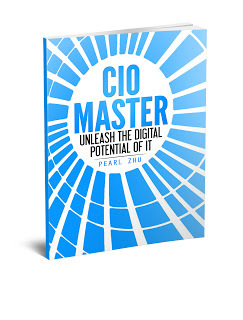Pearl Zhu's Blog, page 1284
October 26, 2016
The Monthly “Digital Compass Oversight: Strategy Execution Effectiveness Oct. 2016
Digital is the age of creativity and innovation, and creativity is all about connecting the dots.
 A digital strategy is cross-functional effort, multidisciplinary, multidimensional planning; it brings up new functions, roles, collaboration, demand for intuition and emergence, complementarities, philosophy, neutron sciences, and trans-disciplinary businesses. And digital strategy execution is not linear steps, but an iterative continuum.
A digital strategy is cross-functional effort, multidisciplinary, multidimensional planning; it brings up new functions, roles, collaboration, demand for intuition and emergence, complementarities, philosophy, neutron sciences, and trans-disciplinary businesses. And digital strategy execution is not linear steps, but an iterative continuum.
Strategy Execution EffectivenessHow to Improve the Success Rate of Strategy Execution: If strategy making is more important, perhaps strategy execution is more difficult. If the strategy is deciding what to do, then execution is all about making it happen via engaged, competent and committed managers and employees. A recent executive survey indicated that execution excellence was the number one challenge facing corporate leaders globally, but more than two third of organizations struggle to implement their strategy smoothly. Hence, organizations need to address this aggressively to really start cranking up their execution abilities. And what are important factors in executing strategy more successfully??Five Key Factors in Strategy Execution? Strategy execution is difficult. A recent executive survey indicated that execution excellence was the number one challenge facing corporate leaders globally. Statistically, about two-thirds to three-quarters of large organizations struggle to implement their strategies. Why does strategy execution unravel, and what are the key factors to lead the effectiveness of strategy execution.Business Strategy Execution Challenges Many companies spend a significant portion of time for formulating rock solid strategies, focuses on business strategy development and puts a lot of efforts to develop a great strategy with strategic initiatives. On the other hand, strategy execution does not get the same attention which leads to misalignment with business objectives and not achieving the expected results. But more specifically, what are the business strategy execution challenges.Why Achieving Execution Excellence is so Hard? Compare to ‘Strategy Hype’-the variety of theories or best practices, books or white papers brainstorming about strategy, execution seems to be the much ‘cooler’ space, do you know why Strategy Execution is a discipline which has not been extensively developed, despite being so crucial?. Strategy Execution: How Difficult Could it Be : Nowadays, with increasing speed of change and fierce competition, business strategy execution is no longer linear steps, but a dynamic continuum. If strategy formulation is more important for leading business toward the right direction, then strategy execution is perhaps more difficult due to the business complexity, uncertainty, time/resource consuming, etc. The strategic themes are essentially the pillars of the organization. They include business growth, operational excellence, customer experience excellence, product development, innovation, and sustainability. Strategic perspectives include financial aspect, customers and stakeholders' aspect, internal processes, organizational capability and engaged leadership. Strategy execution: How difficult could it be?The “Future of CIO” Blog has reached 1.5 million page views with about #3200th blog posting in 59+ different categories of leadership, management, strategy, digitalization, change/talent, etc. The content richness is not for its own sake, but to convey the vision and share the wisdom. Blogging is not about writing, but about thinking and innovating the new ideas; it’s not just about WHAT to say, but about WHY to say, and HOW to say it. It reflects the color and shade of your thought patterns, and it indicates the peaks and curves of your thinking waves. Unlike pure entertainment, quality and professional content takes time for digesting, contemplation and engaging, and therefore, it takes time to attract the "hungry minds" and the "deep souls." It’s the journey to amplify diverse voices and deepen digital footprints, and it's the way to harness your innovative spirit.
Strategy Execution: How Difficult Could it Be : Nowadays, with increasing speed of change and fierce competition, business strategy execution is no longer linear steps, but a dynamic continuum. If strategy formulation is more important for leading business toward the right direction, then strategy execution is perhaps more difficult due to the business complexity, uncertainty, time/resource consuming, etc. The strategic themes are essentially the pillars of the organization. They include business growth, operational excellence, customer experience excellence, product development, innovation, and sustainability. Strategic perspectives include financial aspect, customers and stakeholders' aspect, internal processes, organizational capability and engaged leadership. Strategy execution: How difficult could it be?The “Future of CIO” Blog has reached 1.5 million page views with about #3200th blog posting in 59+ different categories of leadership, management, strategy, digitalization, change/talent, etc. The content richness is not for its own sake, but to convey the vision and share the wisdom. Blogging is not about writing, but about thinking and innovating the new ideas; it’s not just about WHAT to say, but about WHY to say, and HOW to say it. It reflects the color and shade of your thought patterns, and it indicates the peaks and curves of your thinking waves. Unlike pure entertainment, quality and professional content takes time for digesting, contemplation and engaging, and therefore, it takes time to attract the "hungry minds" and the "deep souls." It’s the journey to amplify diverse voices and deepen digital footprints, and it's the way to harness your innovative spirit.
Follow us at: @Pearl_Zhu
 A digital strategy is cross-functional effort, multidisciplinary, multidimensional planning; it brings up new functions, roles, collaboration, demand for intuition and emergence, complementarities, philosophy, neutron sciences, and trans-disciplinary businesses. And digital strategy execution is not linear steps, but an iterative continuum.
A digital strategy is cross-functional effort, multidisciplinary, multidimensional planning; it brings up new functions, roles, collaboration, demand for intuition and emergence, complementarities, philosophy, neutron sciences, and trans-disciplinary businesses. And digital strategy execution is not linear steps, but an iterative continuum.Strategy Execution EffectivenessHow to Improve the Success Rate of Strategy Execution: If strategy making is more important, perhaps strategy execution is more difficult. If the strategy is deciding what to do, then execution is all about making it happen via engaged, competent and committed managers and employees. A recent executive survey indicated that execution excellence was the number one challenge facing corporate leaders globally, but more than two third of organizations struggle to implement their strategy smoothly. Hence, organizations need to address this aggressively to really start cranking up their execution abilities. And what are important factors in executing strategy more successfully??Five Key Factors in Strategy Execution? Strategy execution is difficult. A recent executive survey indicated that execution excellence was the number one challenge facing corporate leaders globally. Statistically, about two-thirds to three-quarters of large organizations struggle to implement their strategies. Why does strategy execution unravel, and what are the key factors to lead the effectiveness of strategy execution.Business Strategy Execution Challenges Many companies spend a significant portion of time for formulating rock solid strategies, focuses on business strategy development and puts a lot of efforts to develop a great strategy with strategic initiatives. On the other hand, strategy execution does not get the same attention which leads to misalignment with business objectives and not achieving the expected results. But more specifically, what are the business strategy execution challenges.Why Achieving Execution Excellence is so Hard? Compare to ‘Strategy Hype’-the variety of theories or best practices, books or white papers brainstorming about strategy, execution seems to be the much ‘cooler’ space, do you know why Strategy Execution is a discipline which has not been extensively developed, despite being so crucial?.
 Strategy Execution: How Difficult Could it Be : Nowadays, with increasing speed of change and fierce competition, business strategy execution is no longer linear steps, but a dynamic continuum. If strategy formulation is more important for leading business toward the right direction, then strategy execution is perhaps more difficult due to the business complexity, uncertainty, time/resource consuming, etc. The strategic themes are essentially the pillars of the organization. They include business growth, operational excellence, customer experience excellence, product development, innovation, and sustainability. Strategic perspectives include financial aspect, customers and stakeholders' aspect, internal processes, organizational capability and engaged leadership. Strategy execution: How difficult could it be?The “Future of CIO” Blog has reached 1.5 million page views with about #3200th blog posting in 59+ different categories of leadership, management, strategy, digitalization, change/talent, etc. The content richness is not for its own sake, but to convey the vision and share the wisdom. Blogging is not about writing, but about thinking and innovating the new ideas; it’s not just about WHAT to say, but about WHY to say, and HOW to say it. It reflects the color and shade of your thought patterns, and it indicates the peaks and curves of your thinking waves. Unlike pure entertainment, quality and professional content takes time for digesting, contemplation and engaging, and therefore, it takes time to attract the "hungry minds" and the "deep souls." It’s the journey to amplify diverse voices and deepen digital footprints, and it's the way to harness your innovative spirit.
Strategy Execution: How Difficult Could it Be : Nowadays, with increasing speed of change and fierce competition, business strategy execution is no longer linear steps, but a dynamic continuum. If strategy formulation is more important for leading business toward the right direction, then strategy execution is perhaps more difficult due to the business complexity, uncertainty, time/resource consuming, etc. The strategic themes are essentially the pillars of the organization. They include business growth, operational excellence, customer experience excellence, product development, innovation, and sustainability. Strategic perspectives include financial aspect, customers and stakeholders' aspect, internal processes, organizational capability and engaged leadership. Strategy execution: How difficult could it be?The “Future of CIO” Blog has reached 1.5 million page views with about #3200th blog posting in 59+ different categories of leadership, management, strategy, digitalization, change/talent, etc. The content richness is not for its own sake, but to convey the vision and share the wisdom. Blogging is not about writing, but about thinking and innovating the new ideas; it’s not just about WHAT to say, but about WHY to say, and HOW to say it. It reflects the color and shade of your thought patterns, and it indicates the peaks and curves of your thinking waves. Unlike pure entertainment, quality and professional content takes time for digesting, contemplation and engaging, and therefore, it takes time to attract the "hungry minds" and the "deep souls." It’s the journey to amplify diverse voices and deepen digital footprints, and it's the way to harness your innovative spirit.Follow us at: @Pearl_Zhu
Published on October 26, 2016 23:16
"Leadership Master" Book Tuning: Three Differentiators in Digital Leadership
 Leadership is about future and change, innovation and influence. The intention of becoming a leader is to inspire and innovate, to improve and advance, to facilitate and encourage, as change is often uncomfortable, yet necessary part of reaching the future and maintaining success. Digital makes everything so transparent, and dynamic, it raises the leadership bar as well. The digital leadership effectiveness is not based on how loud you can speak, or how skillful you can control, but how profound you can influence, to touch both hearts and connect minds. Here are three differentiators in digital leadership.
Leadership is about future and change, innovation and influence. The intention of becoming a leader is to inspire and innovate, to improve and advance, to facilitate and encourage, as change is often uncomfortable, yet necessary part of reaching the future and maintaining success. Digital makes everything so transparent, and dynamic, it raises the leadership bar as well. The digital leadership effectiveness is not based on how loud you can speak, or how skillful you can control, but how profound you can influence, to touch both hearts and connect minds. Here are three differentiators in digital leadership. Eager: Leaders inspire people to think about and reach for what can be. Becoming a leader is a process of becoming your true authentic self in all that you are today and "to be" in the future. Being a leader can on occasion feel isolating, however, by following your instinct you will more often than not turn the situation around and produce a positive outcome. So rather than looking for examples of leaders out there, look within yourself and ask: Why do you want to lead? Which gaps can you fill? Why should others follow you? Being a leader takes one to have the eager to drive changes and a desire to do better than others in certain domains while creating themselves a platform of influence in wherever they are. A good leader is a confident person who will welcome debates and do their utmost to understand and embrace another viewpoint. A leader with eager has the courage to take risks and has the vision to see further. Leaders are great visionaries. They possess an innate potential to transform vision into reality and become the true source of inspiration and motivation for success. Effective leaders facilitate progress and encourage innovation.
Exploring: There is no one size fits all leadership formula. Leadership is the adventure to explore unknown, test uncharted water and take the different path. It’s the journey to help unleash the unlimited human potential. Either being a digital leader or digital professional today, it is not sufficient to do transactional tasks only, you have to continue growing, exploring, innovating and achieve more. A highly innovative organization is surrounded by high potential people who take on new challenges at work, rapidly learn and grow into next-level roles, keep learning for expanding the horizon with growth minds, and they either demonstrate the positive attitude or constructive criticism to build a healthy or even creative workplace.
 Expertise: Nowadays commodity knowledge is only a click away, and the mix of signals and noises make the business world over complex and hyper-risky. Digital leaders today needs to be highly intelligent and highly influential. The qualitative leaders must be very open to knowledge, desire for insight, and hunt for different viewpoints. It's important to keep the ingredients fresh by investing in professional development regularly. At the hyper-connected digital era, to break down stereotypical biases or any types of career ceilings, continuous delivery, expertise power, and dynamic digital footprint become the very significant part of “who you are,” and digital platforms can condense your strength to amplify your leadership influence effortlessly.
Expertise: Nowadays commodity knowledge is only a click away, and the mix of signals and noises make the business world over complex and hyper-risky. Digital leaders today needs to be highly intelligent and highly influential. The qualitative leaders must be very open to knowledge, desire for insight, and hunt for different viewpoints. It's important to keep the ingredients fresh by investing in professional development regularly. At the hyper-connected digital era, to break down stereotypical biases or any types of career ceilings, continuous delivery, expertise power, and dynamic digital footprint become the very significant part of “who you are,” and digital platforms can condense your strength to amplify your leadership influence effortlessly. People are complex, the business is complex, the world is complex, and leadership is complex. The future of leaders has to deal with opposing views, paradox, diverse cultures, constraints and competition. Good leaders are continually practicing, experiencing, learning, sharing, adapting, innovating and maturing, and they understand that ultimate mastery of leadership does not exist. The path to mastery is something that unfolds day by day.
Follow us at: @Pearl_Zhu
Published on October 26, 2016 23:14
The Race for IT Relevance
 Due to the changing nature of technology, the saying about the demise of the internal IT has been around for years. In reality, the majority of IT organizations get stuck in the lower level of maturity, slow to change. CIOs are also in the race for IT relevance, with the pressure to transform IT from a cost center and a commodity service provider to a value created business growth engine. But, how?
Due to the changing nature of technology, the saying about the demise of the internal IT has been around for years. In reality, the majority of IT organizations get stuck in the lower level of maturity, slow to change. CIOs are also in the race for IT relevance, with the pressure to transform IT from a cost center and a commodity service provider to a value created business growth engine. But, how?IT is neither an order taker nor a controller only, IT needs to become a business solutionary: IT needs to be influential enough to impact and provide customers with the right solution, in a right manner, and at a right cost. It doesn’t mean IT should say YES to all customers’ requests or say NO to maintain a status quo. It’s ultimately important for IT to discuss "what's possible" not just "what do you want," this requires a certain depth of understanding the business. However, in many organizations, IT is a cost center, not a business unit. Often, business departments prefer a solution that meets their needs; even further, they don't want solutions that level the playing field and equalize them with their peers, they want something that elevates them. But IT often strives to provide a technology platform that serves all business units for the sake of reduced cost. It's difficult to reconcile these two needs without a great deal of trust and communication. You have to ask yourself then whether you are offering something in your dialogue that really helps them to see how they can differentiate themselves or their business practices.IT can provide valuable insights and tools, and should have the vision to do so. Especially the "what is possible" part, don't just deliver what the business asks for, but be able to provide the "best solution" for the business' requirement, and help the business build the long-term advantage.
IT has to work towards building better credibility and influence and gain respect from business peers: The CIO must be a partner with every aspect of the business. The supporting IT budgets must reflect business priorities and urgency. From both top-down to bottom up, in order to enable the constructive communication, there are leverage point, such as communication of the best tactical actions in support of the business strategy; the sacrifice of a few (products, services, tools, teams) for the advance of the whole; the balance of quick win and long-term benefit, in the face of sometimes wildly variable priorities. Every IT initiative is to help solving the business problems. IT should turn on the ‘debugging mindset’ to do a root cause analysis. Discover what is at the heart of the problem. In many cases, the customer does not really understand the real cause. Once they understand the core problem, then they are able to let go of what they thought would be the best and only answer. IT needs to help the customer focus on the root cause and get away from a preconceived solution if you believe that the proposed solution is not what is best for the company or the customer. Offer added value and feature insights based on system understanding, that the business might not even have thought of. And IT can earn the reputation and build better credibility, and gain respect from business peers via business insight and solid problem-solving capability.
 Avoid the pitfalls at the journey of digital transformation: (1) IT is an afterthought: if the business does not invite the IT leaders to provide input or co-create strategy, IT is developing a different solution than the other department had in mind. Business and IT both should take responsibility if IT is delivering the wrong solution. IT and business should always be on the same page: First, ask managers and leaders about the vision and business problems they are trying to solve, there needs to be a comprehensive audit of the business, to ferret out the problem areas. Once this is done, you can then begin to determine what modifications need to take place, whether it is adding new products or services, building the culture of innovation, or shaping the change capability. (2) Communication is not clear between the participants: Typically, one starts with communication and a process that allows people to discover that both sides of the business want to achieve the best results. The cause of most of the conflict is a lack of trust, in both directions. Trust is earned by business and IT working as a whole, head to head and hand in hand.(3) Non-IT personnel doesn't understand technology thoroughly: Business needs to have empathy and complexity mindset to understand IT better. The issue is not whether IT matters as it clearly does. The issue is whether most business leaders understand how IT matters. Many organizations are not foresightful to empower their IT leaders or lack of in-depth understanding of IT responsibility, technology complexity, the innovative potential and the paradox of IT management
Avoid the pitfalls at the journey of digital transformation: (1) IT is an afterthought: if the business does not invite the IT leaders to provide input or co-create strategy, IT is developing a different solution than the other department had in mind. Business and IT both should take responsibility if IT is delivering the wrong solution. IT and business should always be on the same page: First, ask managers and leaders about the vision and business problems they are trying to solve, there needs to be a comprehensive audit of the business, to ferret out the problem areas. Once this is done, you can then begin to determine what modifications need to take place, whether it is adding new products or services, building the culture of innovation, or shaping the change capability. (2) Communication is not clear between the participants: Typically, one starts with communication and a process that allows people to discover that both sides of the business want to achieve the best results. The cause of most of the conflict is a lack of trust, in both directions. Trust is earned by business and IT working as a whole, head to head and hand in hand.(3) Non-IT personnel doesn't understand technology thoroughly: Business needs to have empathy and complexity mindset to understand IT better. The issue is not whether IT matters as it clearly does. The issue is whether most business leaders understand how IT matters. Many organizations are not foresightful to empower their IT leaders or lack of in-depth understanding of IT responsibility, technology complexity, the innovative potential and the paradox of IT managementThe race for IT relevance is still on, be alert to identify blind spots, be flexible to adjust the planning, be open to listening to the different points of views and be determined when you have to make a tough choice and take the calculated risk. With the increasing speed of change in the Digital Era, IT matters more, not as a commodity service provider, but as a competitive advantage.
Follow us at: @Pearl_Zhu
Published on October 26, 2016 23:10
October 25, 2016
The Monthly CIO Debates Collection How to Run IT as a Better Business Partner Oct. 2016
Debating is not for stimulating conflicts, but for brainstorming better ways to do things.
[image error] Due to the changing nature of technology, IT leadership role also continues to involve & shift the focus, to move up the maturity level. More and more CIOs are requested to take more responsibility and many CIOs present the breadth of leadership competency. The proactive IT debates help IT leaders to brainstorm innovative and better ways to do things, and improve management capabilities. Here are the monthly CIO debates collections for Oct, 2016.
How to Run IT as a Better Business Partner Oct. 2016 How to Run IT as a Better Business Partner Many IT organizations are at transformation journey, from an industrial model to digital leap; from a cost center to value-added; from 'T'-technology driven to 'I'-Information focus, from alignment to engagement. But more specifically, how shall IT leaders run IT as a better business partner?
What are Tactics and Methodologies in Developing IT and Business Relationship? Statistically, only less than 5% of IT can communicate with business partners seamlessly and build IT reputation as a game changer; while more than half of IT organizations still get stuck on the bottom level of maturity, functioning as an isolated support center or service provider due to ineffective communication. Both senior leadership team and CIOs are clear in what needs to achieve in terms of top line, bottom line and working in tandem with other departments to achieve the IT goal. So what are the tactics and methodologies in developing IT and business partner relationship via effective communication?Is IT an Enabler or an Obstacle to Get Things Done in Organizations? In many organizations, IT has been perceived as a controller, a cost center, or even an obstacle to getting things done in the business. What’s the reality of your IT organization? How do you get the non-IT stakeholders to recognize and support the notion that IT and Business are not separate or independent departments? How do you get all stakeholders (IT and non-IT) to encourage the notion that IT and business need to work together to be successful? How do you get non-IT stakeholders to focus on collaboration, transparency, respect, and providing clear leadership?
How Should CIO respond to endless internal customer demand for IT solutions? Modern IT needs to both take care of internal customers by meeting their needs, and to delight end customer by optimizing digital touch points; it has to both map out the strategic projects, but also to keep the light on. How should CIOs prioritize the limited time and resources to ascend IT maturity, and how should CIOs respond to endless internal customer demand for IT solutions? Most of IT organizations fall into the following three types of mentality?
 How to Achieve True Business and IT Partnership? Some say there’s inherent conflict between business and IT, is it true, why are always so many arguments between business and IT, is it possible to achieve a true partnership between Business and IT? If so, what're the key factors and how to achieve it??
How to Achieve True Business and IT Partnership? Some say there’s inherent conflict between business and IT, is it true, why are always so many arguments between business and IT, is it possible to achieve a true partnership between Business and IT? If so, what're the key factors and how to achieve it??
The “Future of CIO” Blog has reached 1.5 million page views with 3200+ blog posting in 59+ different categories of leadership, management, strategy, digitalization, change/talent, etc. blog posting. The content richness is not for its own sake, but to convey the vision and share the wisdom. Blogging is not about writing, but about thinking and innovating the new ideas; it’s not just about WHAT to say, but about WHY to say, and HOW to say it. It reflects the color and shade of your thought patterns, and it indicates the peaks and curves of your thinking waves. Unlike pure entertainment, quality and professional content takes time for digesting, contemplation and engaging, and therefore, it takes time to attract the "hungry minds" and the "deep souls." It’s the journey to amplify diverse voices and deepen digital footprints, and it's the way to harness your innovative spirit.Follow us at: @Pearl_Zhu
[image error] Due to the changing nature of technology, IT leadership role also continues to involve & shift the focus, to move up the maturity level. More and more CIOs are requested to take more responsibility and many CIOs present the breadth of leadership competency. The proactive IT debates help IT leaders to brainstorm innovative and better ways to do things, and improve management capabilities. Here are the monthly CIO debates collections for Oct, 2016.
How to Run IT as a Better Business Partner Oct. 2016 How to Run IT as a Better Business Partner Many IT organizations are at transformation journey, from an industrial model to digital leap; from a cost center to value-added; from 'T'-technology driven to 'I'-Information focus, from alignment to engagement. But more specifically, how shall IT leaders run IT as a better business partner?
What are Tactics and Methodologies in Developing IT and Business Relationship? Statistically, only less than 5% of IT can communicate with business partners seamlessly and build IT reputation as a game changer; while more than half of IT organizations still get stuck on the bottom level of maturity, functioning as an isolated support center or service provider due to ineffective communication. Both senior leadership team and CIOs are clear in what needs to achieve in terms of top line, bottom line and working in tandem with other departments to achieve the IT goal. So what are the tactics and methodologies in developing IT and business partner relationship via effective communication?Is IT an Enabler or an Obstacle to Get Things Done in Organizations? In many organizations, IT has been perceived as a controller, a cost center, or even an obstacle to getting things done in the business. What’s the reality of your IT organization? How do you get the non-IT stakeholders to recognize and support the notion that IT and Business are not separate or independent departments? How do you get all stakeholders (IT and non-IT) to encourage the notion that IT and business need to work together to be successful? How do you get non-IT stakeholders to focus on collaboration, transparency, respect, and providing clear leadership?
How Should CIO respond to endless internal customer demand for IT solutions? Modern IT needs to both take care of internal customers by meeting their needs, and to delight end customer by optimizing digital touch points; it has to both map out the strategic projects, but also to keep the light on. How should CIOs prioritize the limited time and resources to ascend IT maturity, and how should CIOs respond to endless internal customer demand for IT solutions? Most of IT organizations fall into the following three types of mentality?
 How to Achieve True Business and IT Partnership? Some say there’s inherent conflict between business and IT, is it true, why are always so many arguments between business and IT, is it possible to achieve a true partnership between Business and IT? If so, what're the key factors and how to achieve it??
How to Achieve True Business and IT Partnership? Some say there’s inherent conflict between business and IT, is it true, why are always so many arguments between business and IT, is it possible to achieve a true partnership between Business and IT? If so, what're the key factors and how to achieve it??The “Future of CIO” Blog has reached 1.5 million page views with 3200+ blog posting in 59+ different categories of leadership, management, strategy, digitalization, change/talent, etc. blog posting. The content richness is not for its own sake, but to convey the vision and share the wisdom. Blogging is not about writing, but about thinking and innovating the new ideas; it’s not just about WHAT to say, but about WHY to say, and HOW to say it. It reflects the color and shade of your thought patterns, and it indicates the peaks and curves of your thinking waves. Unlike pure entertainment, quality and professional content takes time for digesting, contemplation and engaging, and therefore, it takes time to attract the "hungry minds" and the "deep souls." It’s the journey to amplify diverse voices and deepen digital footprints, and it's the way to harness your innovative spirit.Follow us at: @Pearl_Zhu
Published on October 25, 2016 22:43
Three Talent Management Practices To Build a “Talent Magnet” Workplace
 At the age of digital, businesses today need nothing less than a paradigm shift in their thinking about the fundamentals of how organizations work and fine tune the structure to build an engaging workforce and “talent magnet” workplace. The reality is that the organizational structures and relationships with and between employees were designed for a very different age. It's not just a leadership/ management issue; most organizations are grossly dysfunctional, despite often noble attempts at change by the leadership team. What are the best and next workforce practices to improve employees’ engagement and satisfaction and achieve long term high performance of the business?
At the age of digital, businesses today need nothing less than a paradigm shift in their thinking about the fundamentals of how organizations work and fine tune the structure to build an engaging workforce and “talent magnet” workplace. The reality is that the organizational structures and relationships with and between employees were designed for a very different age. It's not just a leadership/ management issue; most organizations are grossly dysfunctional, despite often noble attempts at change by the leadership team. What are the best and next workforce practices to improve employees’ engagement and satisfaction and achieve long term high performance of the business?Attraction: If businesses are wanting to grow, the first question is how they are attracting people Building an inspiring employer brand is a huge challenge for most companies. It is easier to attract talent than to find it, the challenge for organizations is to attempt to become an "employer of choice." It requires outreach and constantly being on the lookout for opportunities to raise your profile where it can be most productive. So it is important for a company who injects an "employment brand/personality" into their recruiting messaging and efforts. Leveraging digital talent management pipeline and take integral approach. An employer's brand stems from its internal company culture. Leveraging this in recruiting efforts is a great way to attract and retain top candidates.
Engagement: How do you engage people, and then how do their remuneration and performance management systems reinforce the organizational strategy. The “talent magnet” organizations are good at putting the right people with the right capability in the right position to solve the right problems. The studies show that the majority of people are not engaged in their jobs because their talent is not being utilized; though every employee has individual reasons for not being engaged that is rarely revealed by engagement and exit studies. If you have someone in a role where their natural strengths and talents are being recognized and utilized, they will be engaged. They will also have greater passion because they are doing what they are good at doing. It is also important to avoid those barriers. The top culprits of low employee engagement include: poor communication from the top down; lack of development opportunities or career prospects; lack of healthy culture such as fairness, innovation, learning, etc, and lack of visionary leadership to motivate employees and leap their organization up to the next level.
 Potential & Performance management: Performance keeps your business running, and potential enables the business growth, it is important to manage both well. The top team has significant influence for implementing Performance Management into practice in the digital way. The true value of an employee would rather be measured by his or her quality, creativity, and productivity. There is a big difference between cost and quality. The true value of an employee is demonstrated when the employee acts as an ambassador of the organization; brings the advanced digital mindset, knowledge, skills, abilities and personal attitude that translates into expected performance outcomes. A valuable employee is a self motivator who makes positive influence; stays current in their field/profession; freely innovates, creates alternative solutions to existing or emergent problems, figure out the new ways of working; mentors and coaches others (reducing training and development costs and positively impacting on the performance of others), each one of them is also like the magnet to attract more talented people to come to the board. Performance Management should not be confined at the top but to all levels, at strategic areas where Performance Management can give desired results for the business, how to manage performance parameters so that desired results are achieved for the business’s long term prosperity.
Potential & Performance management: Performance keeps your business running, and potential enables the business growth, it is important to manage both well. The top team has significant influence for implementing Performance Management into practice in the digital way. The true value of an employee would rather be measured by his or her quality, creativity, and productivity. There is a big difference between cost and quality. The true value of an employee is demonstrated when the employee acts as an ambassador of the organization; brings the advanced digital mindset, knowledge, skills, abilities and personal attitude that translates into expected performance outcomes. A valuable employee is a self motivator who makes positive influence; stays current in their field/profession; freely innovates, creates alternative solutions to existing or emergent problems, figure out the new ways of working; mentors and coaches others (reducing training and development costs and positively impacting on the performance of others), each one of them is also like the magnet to attract more talented people to come to the board. Performance Management should not be confined at the top but to all levels, at strategic areas where Performance Management can give desired results for the business, how to manage performance parameters so that desired results are achieved for the business’s long term prosperity.Digital workforce planning and management has to become more analytic and systematic, strategic and innovative, do not just think people as cost or resource only, but as assets and capital to invest in. It does mean that whatever workforce management programs you run align with business’s strategic goal; to follow digital trend and leverage the latest digital platforms for developing the next and best practices, to unleash the collective human potential and achieve long term business results.
Follow us at: @Pearl_Zhu
Published on October 25, 2016 22:38
Unleash IT Potential to Accelerate Digital Transformation
 IT is the business, but it is not a business in its own right, rather, a business whose purpose is to enable the core business or drive business growth. In other words, IT should be the same as any other business unit, defining the business goals which it will deliver against and the measures by which success can be assessed. IT is always striving to improve its value to the business. CIOs as digital leaders, how to unleash IT potential to accelerate digital transformation?
IT is the business, but it is not a business in its own right, rather, a business whose purpose is to enable the core business or drive business growth. In other words, IT should be the same as any other business unit, defining the business goals which it will deliver against and the measures by which success can be assessed. IT is always striving to improve its value to the business. CIOs as digital leaders, how to unleash IT potential to accelerate digital transformation?Improving revenue and catalyzing business growth: IT is roughly coupled to the business strategy, often technology is the disruptive force of digital innovation, and information is the “gold mine” of the business. IT can either make or break a company, IT strategy now becomes integral component of business strategy, and history reveals that IT needs to be understood and harnessed by all stakeholders, to fulfill its potential and strategic importance as a differentiator of companies. IT leaders should become the business advisor, and make sure that the executive team first understands what it needs to drive future business growth, put the framework in place to map the strategic objectives into performance measures and then determine what technology investments will accelerate the changes you want to see in your performance indicators.
Improving speed/agility (speed to market, ability to change etc): IT is only increasing in importance and relevance with each passing day. Business expects IT to figure out ways to make the business agiler. IT shifts from “T” technology focused to “I” driven - Information, Intelligence, Innovation, Integration, Improvement, Interface. The numerous perceptions of IT guiding business towards the right direction and to deliver services / solutions address concerns for TCO and future agility. That could mean helping business to implement premium products and solutions so the business is able to efficiently utilize limited capital for bringing more products & services to the market, that could mean creating efficiencies in the processes so business can compete with the competition in terms of offering products & services faster than competitors, Improving Customer Acquisition/Retention (optimize end customer experience): With IT consumerization trend and high level of digital convenience today, IT directly influence a customer's perception of a business. The focus of the CIO’s role has changed from product-oriented to client-oriented. IT has both internal customers and external customers, it needs to improve internal customers’ productivity, and delight external customers via digitizing customer experiences. Deploy a range of technologies that focus purely on improving the customer's experience and perception of business services, showing the customer that you are making significant investment to deliver to them products / services which more closely meet their needs, you are doing so to a greater extent than your competitors. IT enables business innovation to create a value proposition that would move your prospects to become your clients; more importantly, to improve customer retention. To the degree that IT can help companies keep in touch with their prospects and clients in a personalized manner, the greater degree of success that company will experience in comparison to its competition.
Managing risks (reduces business system downtime, create business continuity): Technology brings both significant opportunities and risk for organizations today, the business expects IT to play a critical role in GRC, to ensure rigorous compliance with regulatory requirements and move up business from risk mitigation to risk intelligence, in order to run and protect business flawlessly. There are two aspects to managing risk, assessing it and then evaluating it against acceptable levels (risk appetite.) The CIO will generally drive a periodic risk assessment, usually with the help and input of multiple areas. But it is up to board or other governance body to determine if the risk level identified is acceptable. The CIO does not own the risk, but he/she can (and should ) certainly be tasked with assessing and monitoring the risk on an ongoing basis.
 Optimizing cost (reduces the cost of the current business process, improve margins, freeing up capital for new ventures, etc): Instead of just cost cutting, IT needs to have long term perspective of cost optimization, all IT spending must be rationalized against the business benefits. IT needs to continue fine tuning its own process to achieve operation excellence via consolidation, modernization, integration, optimization, innovation., etc. The approach is to implement a program that like a gardener would prune the tree and nurture the valuable solutions and optimize cost. Pruning the weeds would face resistance, however, at the end of the day, this was not just an IT decision and rather than let the senior management team beat them up, by understanding and communicating the actual costs. IT plays a crucial role in optimizing business operation management capacity with a keen eye to grasp growth opportunities, manage risks, and improve operational efficiency via applying lightweight technologies seamlessly.
Optimizing cost (reduces the cost of the current business process, improve margins, freeing up capital for new ventures, etc): Instead of just cost cutting, IT needs to have long term perspective of cost optimization, all IT spending must be rationalized against the business benefits. IT needs to continue fine tuning its own process to achieve operation excellence via consolidation, modernization, integration, optimization, innovation., etc. The approach is to implement a program that like a gardener would prune the tree and nurture the valuable solutions and optimize cost. Pruning the weeds would face resistance, however, at the end of the day, this was not just an IT decision and rather than let the senior management team beat them up, by understanding and communicating the actual costs. IT plays a crucial role in optimizing business operation management capacity with a keen eye to grasp growth opportunities, manage risks, and improve operational efficiency via applying lightweight technologies seamlessly. IT is about using technology to lower costs, improve operations, and increase revenue. Effective IT management means understanding every island of operation and every workflow process. It is through this comprehensive understanding that a CIO would be able to identify true cost savings, workflow optimizations, customer-centricity, and additional revenue opportunities. Develop an IT organization that is flexible to accommodate rapidly changing business strategies and requirements, unleash its full potential to accelerate digital transformation.
Follow us at: @Pearl_Zhu
Published on October 25, 2016 22:36
October 24, 2016
The CIO’s Digital Agenda: Tuning IT Organizational Structure for Business Friendly and Digital Ready Oct. 2016
 IT is the foundation of data, information, and modern knowledge. The biggest misnomer regarding IT is that it is "just technology." The most powerful and differentiating tool in all of the today's businesses is INFORMATION and that, is provided by IT systems. How to continually fine-tune IT and get digital ready?
IT is the foundation of data, information, and modern knowledge. The biggest misnomer regarding IT is that it is "just technology." The most powerful and differentiating tool in all of the today's businesses is INFORMATION and that, is provided by IT systems. How to continually fine-tune IT and get digital ready?Tuning IT Organizational Structure for Business Friendly and Digital Ready Oct. 2016How to Structure a Business-Friendly IT Organization? Due to the changing nature of technology, IT organization also has to continue to re-imagine, reinvent and reshuffle itself to adapt to the changes. But the goal for changes or IT transformation is ultimately for achieving business goals. So the point is what are the fair reasons to do IT reorganization and how to structure a business-friendly IT organization?
The “Digital Way” of an Organizational Structure and Beyond? Organizations large or small are on the journey to digital transformation, and there are different theories of organizational structure evolution and continuous brainstorming about the concept of self-management, the format of future of the organization - from Holacracy to sociocracy; from agile to Stoos, etc. The whole point is how to build a more creative and productive working environment in which the employees’ talent can be unleashed; and business as a whole is more optimal than the sum of pieces, in order to adapt to the change with the accelerating speed? Ultimately, what's the digital way to run a business.
Three Considerations in Reinvent IT Organizational Structure? Many IT organizations or enterprise as a whole intend to reinvent their “stale” working environment with 20th culture such as bureaucracy, inertia to change, reward mediocrity, homogeneous leadership & talent team, over-complex business processes, inefficient communication pipelines, etc. However, reinventing organizational structure is not an easy task, it takes both strategic planning and operational alignment to make it work and improve organizational maturity. Below is some collective insight on how to reinvent IT organizational structure and build more creative and productive working environment.
Building a Self-adaptive Digital Organization? Digital means flow; digital organizations have to adapt to the continuous changes and business dynamic in striving as digital master. Within system engineering, self-adaptive concepts are applied in order to control system risks that evolve due to dynamics and variation. The self-adaptive system is a system able to re-configure its own structure and change its own behavior during the execution of its adaptation to environment changes?
 CIO Reporting Structure: Does it Matter to IT Maturity? Ever since the "early days" (the 1980s), IT has frequently reported through the business/CFO channel. This is the true state of CIOs today. However, IT is transforming from a cost center to value creator, from IT-business alignment to IT-business engagement; from IT as back office support function to front office innovation engine, what is the ideal CIO reporting structure, does it matter to IT maturity?
CIO Reporting Structure: Does it Matter to IT Maturity? Ever since the "early days" (the 1980s), IT has frequently reported through the business/CFO channel. This is the true state of CIOs today. However, IT is transforming from a cost center to value creator, from IT-business alignment to IT-business engagement; from IT as back office support function to front office innovation engine, what is the ideal CIO reporting structure, does it matter to IT maturity?The “Future of CIO” Blog has reached 1.5 million page views with 3200+ blog posting in 59+ different categories of leadership, management, strategy, digitalization, change/talent, etc. blog posting. The content richness is not for its own sake, but to convey the vision and share the wisdom. Blogging is not about writing, but about thinking and innovating the new ideas; it’s not just about WHAT to say, but about WHY to say, and HOW to say it. It reflects the color and shade of your thought patterns, and it indicates the peaks and curves of your thinking waves. Unlike pure entertainment, quality and professional content takes time for digesting, contemplation and engaging, and therefore, it takes time to attract the "hungry minds" and the "deep souls." It’s the journey to amplify diverse voices and deepen digital footprints, and it's the way to harness your innovative spirit.Follow us at: @Pearl_Zhu
Published on October 24, 2016 23:06
Five Principles to Reach Decision Maturity
 One significant effect of digitization is increased velocity, complexity, ambiguity, unpredictability, and a need for a faster response to changes in business and industry based on effective and efficient decision making. How is that possible? Decision making is both art and science, especially for business leaders, making either strategic or tactical decision effectively is one of the most critical responsibilities facing them every day. How to set principles and guidelines in reaching the high level of decision maturity in your organization?
One significant effect of digitization is increased velocity, complexity, ambiguity, unpredictability, and a need for a faster response to changes in business and industry based on effective and efficient decision making. How is that possible? Decision making is both art and science, especially for business leaders, making either strategic or tactical decision effectively is one of the most critical responsibilities facing them every day. How to set principles and guidelines in reaching the high level of decision maturity in your organization?Frame the right questions before hunting for the right answers: Inappropriate framing is being the root cause of most bad decisions. Often time, people rush up to make decisions or jump to the conclusion even without understanding the real issues. Many times, framing the right question is one of the most crucial steps in decision-making. It is the step decision makers can slow down and think through the implications of their intuitive, subjective assumptions. This is particularly important for strategic decision-making. In the senior position, stay on strategic focus, CXOs should be able to understand the real issue, count on the answer and understand the scope of the answer and any constraints on validity or accuracy. But that too should be part of the answer. That said, knowing enough about analytic processes provides insight and improves communication in order to make effective decisions. Leverage Systems Thinking and multidimensional thinking process in strategic decision making: Systems thinking is nothing more than the good combination of analytic and synthetic thinking, to understand the interconnectivity between parts and the whole, see the trees without missing the forest. Decision makers have to leverage different variables, try to identify the parts of a system and how those parts are connected, look at things from different angles, think about how change over time has influenced the current situation, also try to identify potential unintended consequences of our actions. This holistic examination of issues/problems takes time, but worth the effort for avoiding blind spots and improving decision effectiveness.
Collective insight is invaluable: One interpretation of information may differ greatly from another interpretation of that same information. Avoid group thinking syndrome in decision making. It is always beneficial to communication, interpretation and accuracy of overall results when multiple heads with cognitive difference come together to interpret and define data sources and outcomes. The more engaged the business leader in accessing information and understanding where it is extracted and how it is compiled, the better and more understood the results. Decisions are still made by people, so the challenge is to get the relevant people communicating with each other more efficiently, and making the best use of the digital tools.
Intuition has its place in decision making, but clarify your gut: What might be identified as "intuition" is probably subconscious rapid assessment through a decision tree to come up with an appropriate and timely response to an unfolding situation. Your gut feeling will play a role, but by asking simple questions like how do you know, what evidence do you have, is it your opinion or a fact, makes decisions less biased. Breaking the "problem down," rather than making one big "gut decision," can reveal inappropriate bias, and creates an audit trail. More work needs to be done on creating a healthy environment for intuition to be valued and respected. In practice, more often than not, it’s about striking the right balance of both analytics and intuition for making effective decisions.
 Making the effective decisions TIMELY: It is often said that a wrong decision taken at the right time is better than a right decision taken at the wrong time.Behind every decision, there is always an element of uncertainty and doubt. It is up to the decision maker how he/she handles it. Reaction-to-action time would be enhanced by one's upwards learning curve or accumulation of such information, at the same time "speed" may be offset or enhanced by new problem-solving approaches/tools used. But significantly, decisions are to be made on time, and this is more imperative, when uncertainty and doubts are major hindrances to decision making. You can't wait for all the information, data, etc., ready to take a decision. No decision in the world outlives the time, place and persons constituents on the basis of which it was made. Timing is always critical for decision making effectiveness.
Making the effective decisions TIMELY: It is often said that a wrong decision taken at the right time is better than a right decision taken at the wrong time.Behind every decision, there is always an element of uncertainty and doubt. It is up to the decision maker how he/she handles it. Reaction-to-action time would be enhanced by one's upwards learning curve or accumulation of such information, at the same time "speed" may be offset or enhanced by new problem-solving approaches/tools used. But significantly, decisions are to be made on time, and this is more imperative, when uncertainty and doubts are major hindrances to decision making. You can't wait for all the information, data, etc., ready to take a decision. No decision in the world outlives the time, place and persons constituents on the basis of which it was made. Timing is always critical for decision making effectiveness. Decision maturity is to ensure the right decisions have been made by the right people at the right time. There is fuzziness in the decisions because there is fuzziness in conflicting criteria. At the Digital Era, making decisions in digital ways means to leverage multidimensional thinking process, advanced decision tools, the human’s intuition-gut feelings, and add the “wisdom’ in the decision process to improve the overall effectiveness of decision making.
Follow us at: @Pearl_Zhu
Published on October 24, 2016 23:01
The Digital CIO’s Five Priorities in Daily Grinding
 Being a contemporary CIO is a tough job facing unprecedented complexity and numerous dilemmas, due to change nature of technology and exponential growth of information, CIOs seem to be always in the hot seat, with the pressure to reinvent IT to adapt to changes. Since so many CIOs have been perceived as tactical IT managers, rather than visionary business leaders, and business still thinks IT as a service desk, rather than a strategic partner. The forward-looking CIO has to build his/her credibility as a trusted advisor for the business via setting the right priority in the key areas which need daily focus and manage the time and resource effectively.
Being a contemporary CIO is a tough job facing unprecedented complexity and numerous dilemmas, due to change nature of technology and exponential growth of information, CIOs seem to be always in the hot seat, with the pressure to reinvent IT to adapt to changes. Since so many CIOs have been perceived as tactical IT managers, rather than visionary business leaders, and business still thinks IT as a service desk, rather than a strategic partner. The forward-looking CIO has to build his/her credibility as a trusted advisor for the business via setting the right priority in the key areas which need daily focus and manage the time and resource effectively. Strategic focus -CIOs need to spend a significant amount of time on strategic matters in their daily grinding. CIOs have to get the transformation agenda right to refine IT reputation and have access to resources (external and internal) to achieve the desired ROI. The CIO should always come to strategy meeting well-prepared because IT strategy is key INPUT of business strategy. IT strategy is not a "to-do list," but an integral component of business strategy. Ideally, IT strategy should provide the unique set of 'capability' to the business and offer different options and flexibility to address the business challenges or opportunities, and then will be asked to deliver the necessary capabilities to support the agreed new business strategy. IT faces unprecedented opportunity to refine its reputation, also needs to take more responsibility as a true business partner. It is an opportunity to demonstrate execution of responsibility. IT is always asking to be recognized as a strategic business enabler and now that it actually has an opportunity to be the one.
Business Engagement – Spend time with key business teams and understanding which direction organization is progressing. In most of the organizations, IT is setting back and waiting for the request. IT needs to be proactive, not reactive. IT has to be a consultant and advisor to the business to maximize the revenue. IT leaders should understand the business view on IT, and keep refining the IT strategy to meet business needs. Be authentic in your leadership and care about the business. By caring, it doesn't mean you lose the ability to make tough decisions but through your reputation, your actions will be interpreted positively, even though for individuals and/or business functions it may not always be. IT has to be configured in a way to understand the business and set the architecture to deliver the business and market need. Projects//Portfolio/Operations Review – Check the executive scorecard automated dashboards to review key people, finance, operational and project deliverables. Operation review to “keep the lights on,” is still fundamental, and project portfolio management to balance “run-grow-transform” is one of the most important tasks for IT continuous deliveries. The organizations who are so successful in delivering its IT projects is to ensure that there is READINESS among other important aspects of schedule, scope and cost. Plan, implement and measure them well are the key step in delivering expected result. Hence, CIOs should leverage scoreboard and other management tools for ensuring on quality, on value, and on-time delivery.
Personal development –The CIO is the leadership role, not just a management job. Leadership is not a setting- hour job, but a continuous self-mastery journey. Your leadership vision is based on the breadth of knowledge and the depth of insight. CIOs need to spend time on learning, mastery, set the strong leadership tone to build the culture of learning in their IT organizations. CIO attributes have moved in such a way that the cutting edge IT type is not enough, digital mindsets, nonlinear skillset, and integrative capabilities are required. Keep Industry connections warm, Leverage tools to capture the technology or market trends, and envision the future of IT. The world moves too fast and marketing, finance, technology, leadership are all intertwined. You have to be well-rounded to succeed as an executive. The person who moves up the IT ranks and thus landing in the CIO spot will also need to have an inherent knowledge of the business, because every IT project is business initiative, and every modern business function has IT embedded in it.
 Develop your people - Dedicate open door time for people to come and discuss any challenges, or share any innovative ideas and creative problem solving. People are the center of the business, often the weakest link as well. Assuming the CIO has the proper empowerment, and it is targeted toward making good people decisions vs. protecting its position within the organization, he/she should need critical thinking or the structured thinking upon talent strategy, and well align the employee’s career goal with the business strategy. Many organizations have forgotten one of their main social responsibilities, people development. This is also a long-term view and one of the main causes of business failure. CIOs’ talent management approach includes the capacity to appraise the potentialities of co-workers, build a creative, productive, and fair working environment, encourage people to express “who they are” with authenticity, become “who they want to be,” and bring wisdom to the workplace.
Develop your people - Dedicate open door time for people to come and discuss any challenges, or share any innovative ideas and creative problem solving. People are the center of the business, often the weakest link as well. Assuming the CIO has the proper empowerment, and it is targeted toward making good people decisions vs. protecting its position within the organization, he/she should need critical thinking or the structured thinking upon talent strategy, and well align the employee’s career goal with the business strategy. Many organizations have forgotten one of their main social responsibilities, people development. This is also a long-term view and one of the main causes of business failure. CIOs’ talent management approach includes the capacity to appraise the potentialities of co-workers, build a creative, productive, and fair working environment, encourage people to express “who they are” with authenticity, become “who they want to be,” and bring wisdom to the workplace. Every CIO is unique, how CIOs provide the appropriate leadership and how they convey to leverage IT for business value depends on CIOs' vision and leadership strength and style. Digital CIOs need to be both intelligent and diligent, strategic and innovative, influential and open-minded. Every CIO is different and whatever the management team needs or wants at the time out of the CIO will also be different, and by type of business needs will be different. It’s whether you can be what is needed at the time and execute to those expectations. But for the long run, be a visionary and transformational leader, not just a transactional manager.
Follow us at: @Pearl_Zhu
Published on October 24, 2016 22:57
October 23, 2016
The “CIO Master” Monthly Book Tuning: Reinvent IT for the Digital Age Oct. 2016
Digital IT needs to become more dynamic and innovative to be a pathfinder for the digital transformation.
 Modern CIOs have many personas and face great challenges. It is not sufficient to only keep the light on. Regardless of which industry or the nature of organization you are in, being a digital leader will need to master the art of creating unique, differentiating value from piles of commoditized technologies, but more specifically, what are the digital-savvy CIOs doing to run IT as a change agent and digital transformer? Here is the monthly “CIO Master” Book Tuning.
Modern CIOs have many personas and face great challenges. It is not sufficient to only keep the light on. Regardless of which industry or the nature of organization you are in, being a digital leader will need to master the art of creating unique, differentiating value from piles of commoditized technologies, but more specifically, what are the digital-savvy CIOs doing to run IT as a change agent and digital transformer? Here is the monthly “CIO Master” Book Tuning.
Reinvent IT for the Digital Age Oct. 2016The Art of Possible: How to Shift from Transactional IT to Transformational IT Even though IT permeates to almost every corner of the business, many traditional IT organizations are still perceived as an invisible back office maintenance function, without sufficient knowledge about the business model of the organization. Although technology is often the disruptive force behind changes and digital transformation, most IT organizations get stuck at the lower level of maturity, running as a reactive service provider. CIOs as business strategists: How to pursue the art of possible - Make a shift from a mechanical IT to innovative IT? From a reactive IT to accelerating IT? And from transactional IT to transformational IT?
Tapping the Digital Transformation Power of IT”: Technology is pervasive, IT touches both hard business processes and soft human behavior. Digital transformation or business initiatives today nearly always involves some form of technology implementation or information analysis. And history reveals that IT needs to be understood and harnessed by all stakeholders, to fulfill its potential and strategic importance as a strategic differentiator of the company. But more specifically, how can forward-looking organizations tap the digital transformation power of IT to improve business efficiency, effectiveness, responsiveness, and maturity?
Reinventing IT via Digitization, Simplification and innovation? IT organizations are facing significant transformation, perhaps crossroad is an appropriate word to articulate IT position: Should IT keep running as a transactional support desk or cost center, or can IT reinvent itself as a changing organization to drive digital transformation of the business via digitization, simplification, and innovation?
Three Digital Tuning to Rejuvenate IT Organization: With the increasing speed of change and exponential growth of information, the overly restricted hierarchical organizations are no longer effective enough to adapt to the changes and keep information flow seamlessly, because speed is a key imperative these days and “silo” mentality as a product of rigid hierarchy hinders flexibility and agility. People, process, and technology, how to fine-tune those key business elements to rejuvenate IT and the company as a whole to improve its effectiveness, responsiveness, and maturity?
 From Here to There: How to Run an Always-on IT Digital Transformation? At today’s “VUCA” digital dynamic, hyperconnected and always on business working environment, IT is on the journey of digital shift, forward-thinking companies empower IT to play a crucial role in leading the digital transformation of the entire company. CIOs have to deal with constant ambiguity, increasing complexity, rapid change, and unprecedented uncertainty. From here to there, it is a thorny journey. CIOs as top leaders have to be humble to realize there are many things you know you don’t know and perhaps even more which you don't know what you don't know, what’s the premium way to run an always-on IT digital transformation.
From Here to There: How to Run an Always-on IT Digital Transformation? At today’s “VUCA” digital dynamic, hyperconnected and always on business working environment, IT is on the journey of digital shift, forward-thinking companies empower IT to play a crucial role in leading the digital transformation of the entire company. CIOs have to deal with constant ambiguity, increasing complexity, rapid change, and unprecedented uncertainty. From here to there, it is a thorny journey. CIOs as top leaders have to be humble to realize there are many things you know you don’t know and perhaps even more which you don't know what you don't know, what’s the premium way to run an always-on IT digital transformation.
The “Future of CIO” Blog has reached 1.5 million page views with about #3000th blog posting in 59+ different categories of leadership, management, strategy, digitalization, change/talent, etc. The content richness is not for its own sake, but to convey the vision and share the wisdom. Blogging is not about writing, but about thinking and innovating the new ideas; it’s not just about WHAT to say, but about WHY to say, and HOW to say it. It reflects the color and shade of your thought patterns, and it indicates the peaks and curves of your thinking waves. Unlike pure entertainment, quality and professional content takes time for digesting, contemplation and engaging, and therefore, it takes time to attract the "hungry minds" and the "deep souls." It’s the journey to amplify diverse voices and deepen digital footprints, and it's the way to harness your innovative spirit.
Follow us at: @Pearl_Zhu
 Modern CIOs have many personas and face great challenges. It is not sufficient to only keep the light on. Regardless of which industry or the nature of organization you are in, being a digital leader will need to master the art of creating unique, differentiating value from piles of commoditized technologies, but more specifically, what are the digital-savvy CIOs doing to run IT as a change agent and digital transformer? Here is the monthly “CIO Master” Book Tuning.
Modern CIOs have many personas and face great challenges. It is not sufficient to only keep the light on. Regardless of which industry or the nature of organization you are in, being a digital leader will need to master the art of creating unique, differentiating value from piles of commoditized technologies, but more specifically, what are the digital-savvy CIOs doing to run IT as a change agent and digital transformer? Here is the monthly “CIO Master” Book Tuning.
Reinvent IT for the Digital Age Oct. 2016The Art of Possible: How to Shift from Transactional IT to Transformational IT Even though IT permeates to almost every corner of the business, many traditional IT organizations are still perceived as an invisible back office maintenance function, without sufficient knowledge about the business model of the organization. Although technology is often the disruptive force behind changes and digital transformation, most IT organizations get stuck at the lower level of maturity, running as a reactive service provider. CIOs as business strategists: How to pursue the art of possible - Make a shift from a mechanical IT to innovative IT? From a reactive IT to accelerating IT? And from transactional IT to transformational IT?
Tapping the Digital Transformation Power of IT”: Technology is pervasive, IT touches both hard business processes and soft human behavior. Digital transformation or business initiatives today nearly always involves some form of technology implementation or information analysis. And history reveals that IT needs to be understood and harnessed by all stakeholders, to fulfill its potential and strategic importance as a strategic differentiator of the company. But more specifically, how can forward-looking organizations tap the digital transformation power of IT to improve business efficiency, effectiveness, responsiveness, and maturity?
Reinventing IT via Digitization, Simplification and innovation? IT organizations are facing significant transformation, perhaps crossroad is an appropriate word to articulate IT position: Should IT keep running as a transactional support desk or cost center, or can IT reinvent itself as a changing organization to drive digital transformation of the business via digitization, simplification, and innovation?
Three Digital Tuning to Rejuvenate IT Organization: With the increasing speed of change and exponential growth of information, the overly restricted hierarchical organizations are no longer effective enough to adapt to the changes and keep information flow seamlessly, because speed is a key imperative these days and “silo” mentality as a product of rigid hierarchy hinders flexibility and agility. People, process, and technology, how to fine-tune those key business elements to rejuvenate IT and the company as a whole to improve its effectiveness, responsiveness, and maturity?
 From Here to There: How to Run an Always-on IT Digital Transformation? At today’s “VUCA” digital dynamic, hyperconnected and always on business working environment, IT is on the journey of digital shift, forward-thinking companies empower IT to play a crucial role in leading the digital transformation of the entire company. CIOs have to deal with constant ambiguity, increasing complexity, rapid change, and unprecedented uncertainty. From here to there, it is a thorny journey. CIOs as top leaders have to be humble to realize there are many things you know you don’t know and perhaps even more which you don't know what you don't know, what’s the premium way to run an always-on IT digital transformation.
From Here to There: How to Run an Always-on IT Digital Transformation? At today’s “VUCA” digital dynamic, hyperconnected and always on business working environment, IT is on the journey of digital shift, forward-thinking companies empower IT to play a crucial role in leading the digital transformation of the entire company. CIOs have to deal with constant ambiguity, increasing complexity, rapid change, and unprecedented uncertainty. From here to there, it is a thorny journey. CIOs as top leaders have to be humble to realize there are many things you know you don’t know and perhaps even more which you don't know what you don't know, what’s the premium way to run an always-on IT digital transformation.The “Future of CIO” Blog has reached 1.5 million page views with about #3000th blog posting in 59+ different categories of leadership, management, strategy, digitalization, change/talent, etc. The content richness is not for its own sake, but to convey the vision and share the wisdom. Blogging is not about writing, but about thinking and innovating the new ideas; it’s not just about WHAT to say, but about WHY to say, and HOW to say it. It reflects the color and shade of your thought patterns, and it indicates the peaks and curves of your thinking waves. Unlike pure entertainment, quality and professional content takes time for digesting, contemplation and engaging, and therefore, it takes time to attract the "hungry minds" and the "deep souls." It’s the journey to amplify diverse voices and deepen digital footprints, and it's the way to harness your innovative spirit.
Follow us at: @Pearl_Zhu
Published on October 23, 2016 22:04



